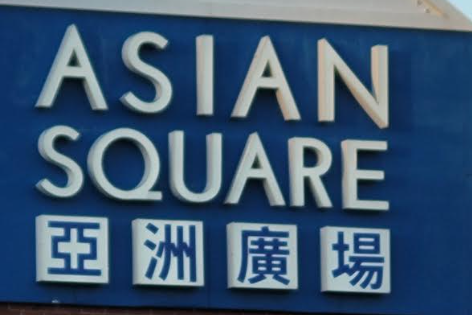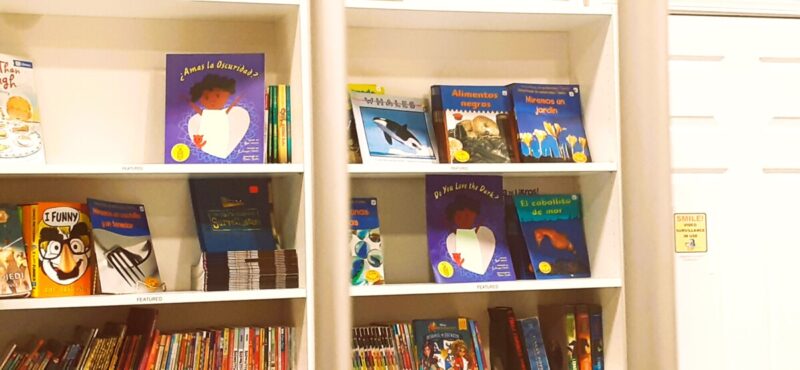By: Faith McHan
Introduction
In this project, I analyzed the signs in Asian Square, a shopping center located in Doraville, Georgia on Buford Highway, an area that is known for having sizable Asian and Hispanic populations. Doraville in particular has a majority-Hispanic population, with 5,220 residents being Hispanic out of a total 10,244 residents as of 2020 (“ACS Demographic and Housing Estimates”). In Doraville, 34.7% of residents only speak English at home, 45.6% speak Spanish, and 7.7% speak Asian languages (“Selected Social Characteristics in the United States”). In this project, I analyzed which languages were more likely to be displayed on the permanent and temporary signs in Asian Square. I also analyzed if there were any associations between the colors used on signs and the languages used. My goal in doing this research was to be able to see which languages are perceived as being more important or necessary by the shop owners of the businesses in Asian Square.
Research Design
I collected my data by taking pictures of all the signs I saw, and I ended up with pictures of 111 unique signs. In order to restrict the amount of data I collected, I only took pictures of the signs that were visible from the outside of the stores. There were a few instances where the shop owner had made or purchased one sign design and then printed it out multiple times, thus resulting in several identical copies of the same sign (Figure 1).
In these instances, I only counted the sign once since it was only one unique design. After taking pictures of the signs, I then divided them into three groups: permanent signs (i.e., signs that would not easily be taken down or replaced, Figure 2), temporary signs that were handmade (i.e., signs that clearly had been handwritten or typed up on a basic computer and then printed, Figure 3), and temporary signs that had been purchased (i.e., signs that were clearly not made by the shop owner, Figure 4). Then, I noted the language(s) featured in each sign, as well as the primary color of each sign, which I defined as the color that appeared most frequently on the written text of the sign. I did not note which language(s) were most prominent on each sign. I then quantified the data to see which languages and colors were more common for each of the three groups that I had identified.
Results
Permanent signs, n = 44

Temporary signs that had been purchased, n = 37

Temporary signs that were handmade, n = 30

Primary colors on the permanent signs, n = 44

Analysis and Discussion
There were five languages that I noted in the signs in Asian Square: English, Chinese, Vietnamese, Spanish, and Malay. However, Malay only appeared once, so I will be ignoring it throughout this analysis. In each of the three groups of signs, English was the most common language overall, with Chinese, written both in the traditional and simplified script, following.
One notable difference I observed between the permanent signs and the temporary signs, both handmade and purchased, was that the use of Spanish was higher with the temporary signs. For the permanent signs, only 5.41% of signs had Spanish, with 0% of them displaying Spanish only. In contrast, for the temporary signs that were purchased, 16.22% of signs had Spanish, with 2.70% displaying Spanish only, and for the temporary signs that were handmade, 23.33% of signs had Spanish, with 0% of them displaying Spanish only. The fact that Spanish increases in use for the temporary signs suggests that the owners or creators of the Asian Square shopping center were not originally intending to appeal to a Spanish-speaking clientele. The fact that the temporary signs use more Spanish could indicate that the shop owners are now trying to accomodate the Spanish-speaking population without necessarily appealing directly to them. Additionally, the fact that the only sign to solely have Spanish on it is a sign that had been purchased rather than handmade suggests that the owners of the businesses at Asian Square do not speak Spanish themselves (Figure 5).
Another observation is that, though the total use of Chinese was higher than the total use of Vietnamese for all three of the groups I identified, the amount of signs written solely in Vietnamese is higher than the amount of signs written solely in Chinese, either traditional or simplified script, for both groups of temporary signs. For the permanent signs, 4.55% only have Vietnamese and 4.55% only have Chinese. For the temporary purchased signs, 8.11% only have Vietnamese and 5.41% only have Chinese, and for the temporary handmade signs, 10% only have Vietnamese and 6.67% only have Chinese. This increase in the use of Vietnamese found in the temporary signs suggests that the use of Vietnamese among the store owners may be increasing.
Aside from the languages themselves, the colors used in the different signs reveal an interesting pattern. For the signs that feature English and another language, 60.17% of these signs had red as the primary color. For the signs that only featured non-English languages, 100% used red as their primary color. For signs that solely used English, there was no color that was used by the majority of the signs, though 72.73% of these signs used a color other than red. The fact that the signs that use non-English languages in any capacity show a strong preference for red, while the signs that only use English show a strong preference against red suggests that the color red may be seen by the shop owners as a way to signal that they’re appealing towards a non-English speaking population and vice versa.
Finally, another trend that I noticed is that traditional Chinese is much more common in the permanent signs than either of the two types of temporary signs. This could be an indication of the time period or the location where the original shop owners immigrated from. For example, the use of the traditional script is much more common nowadays in Hong Kong, Taiwan, and Macau, while the simplified script is more common in China, Malaysia, and Singapore. Thus, the use of traditional Chinese for the permanent signs could indicate that the original shop owners immigrated from an area where the traditional script is more commonly used, or it could indicate that they immigrated at an earlier time.
One notable shortcoming in my research is my inability to determine what language is represented by the Chinese script in the signs. As I noted previously, Chinese was the second-most common language found in each of the three groups. However, though I distinguished between traditional and simplified script, looking at the Chinese script only is not sufficient to tell me what Chinese language I’m looking at. Since various Chinese languages, such as Mandarin, Cantonese, Hokkien, Shanghainese, among others, all use the Chinese characters as their writing system, I cannot actually tell what language is represented by the signs written in this script. Additionally, other Asian languages like Vietnamese and Korean can also be written in Chinese characters, though this isn’t incredibly common in modern times. Thus, it is entirely possible that the use of Chinese has been over-represented in this analysis. One possible next step to fix this problem could entail going to each shop owner who has signs written using the Chinese script and asking them what language they were intending to write in.
Works Cited
“ACS Demographic and Housing Estimates.” American Community Survey, United States Census Bureau, 2020.
“Selected Social Characteristics in the United States.” American Community Survey, United States Census Bureau, 2020.





1 Comment
Add Yours →This is an extremely interesting research project with intriguing results, Faith. I thought it was really interesting to see how signage type affected the frequency of certain languages presented. I agree with your assumption that the use of Spanish in temporary signs indicates that the original beginnings of Asian Square did not cater to Spanish speakers, but now are welcomed. I also thought the usage of red in non-English signage was extremely interesting. I think a further analysis of this and possibly exploring the meaning of red within these different communities could provide better insight as to why red is so prominent. Furthermore, I love how your research results provide possible history and origins of Asian Square, specifically through the usage of traditional Chinese. It makes me wonder if there will be a point where those signs need to be changed to better reflect the rising use of simplified Chinese.